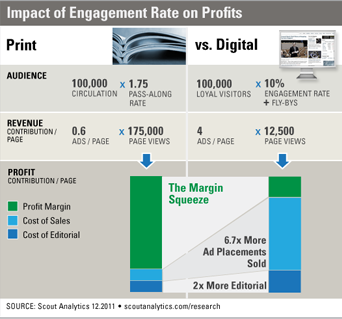Engagement rate, the percentage of the audiences that consumes a particular piece of editorial content, creates the biggest squeeze on digital advertising profits. The advertising profit contribution of media is defined by the advertising revenue produced from page views minus the costs to create the content and sell the advertising. Unlike print media that uses circulation and pass-along rate to define sellable inventory of page views, digital media uses audience size and engagement rate. While pass-along rate acts as a page view multiplier on circulation, engagement rate is a page view filter on audience size. The consequence is that engagement rate puts a squeeze of advertising profit margins.
To illustrate this point, the infographic below benchmarks advertising profit contribution of ad sales and editorial of print vs. digital. As in previous comparisons, this example assumes the print product is a 50-page magazine with 30 advertisements which means for every additional page of editorial the sales team needs to sell 0.6 ad placements. On the other hand, for every page of editorial in digital the sales teams typically needs to sell 4 ad placements which is an increase of 6.7 times more insertion orders vs. print. On the surface, it appears like the increased cost of sales would result in more revenue (i.e., 4 ads vs. 0.6) but this is where engagement rate impacts the revenue and profits.
Scout® Research consistently finds that the engagement rate for an individual piece of editorial is rarely above 10%. Average engagement rates across all editorial within a site are usually below 10%. So at a 10% average engagement rate, which is very good, a page of digital editorial in the infographic example will generate 50,000 sellable advertising impressions (i.e., 100,000 members X 10% engagement rate X 4 ads per page view + 20% additional from fly-bys). In contrast, the 0.6 ads per page in print multiplied by 100,000 circulation and the 1.75 pass-along rate results in 105,000 sellable advertising impressions. To make up for the drop in sellable impressions, the digital editorial team has to create two times more content.
Research consistently finds that the engagement rate for an individual piece of editorial is rarely above 10%. Average engagement rates across all editorial within a site are usually below 10%. So at a 10% average engagement rate, which is very good, a page of digital editorial in the infographic example will generate 50,000 sellable advertising impressions (i.e., 100,000 members X 10% engagement rate X 4 ads per page view + 20% additional from fly-bys). In contrast, the 0.6 ads per page in print multiplied by 100,000 circulation and the 1.75 pass-along rate results in 105,000 sellable advertising impressions. To make up for the drop in sellable impressions, the digital editorial team has to create two times more content.
In other words, to get to the same revenue assuming digital and print CPM consistency, the digital team has to sell 6.7 times more advertising and produce 2 times more content. This is the advertising profit margin squeeze.
Engagement rate has at least two immediate implications.
The first is that given the impact on advertising profits, engagement rate is an important new metric for managing digital. Engagement rate informs the publisher about the priorities for profits. With a low engagement rate, a publisher needs to improve profits through audience development. With a high engagement rate, a publisher needs to improve profits through more editorial.
The second implication is that engagement rate creates a structurally different profit model for digital advertising compared to print. A structural difference that cannot be overcome except through diversification of the revenue model or a rethinking of advertising.
Have a comment? Please share!






